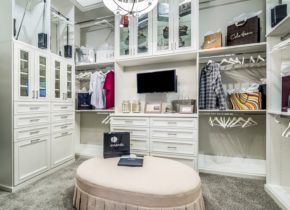 No matter the size of our bedrooms, we’re often more concerned with the size of our closets. They’re never big enough. One reason is that our closets today are not just for hanging clothes. In many cases, they have replaced bedroom furniture and now have built-in drawers and cabinets. We have hooks to hang belts, ties, robes and hats; and pull-out hooks for when we bring dry cleaning home or need to organize for travel. We even have seating to put on our shoes and mirrors for checking to see how we look.
No matter the size of our bedrooms, we’re often more concerned with the size of our closets. They’re never big enough. One reason is that our closets today are not just for hanging clothes. In many cases, they have replaced bedroom furniture and now have built-in drawers and cabinets. We have hooks to hang belts, ties, robes and hats; and pull-out hooks for when we bring dry cleaning home or need to organize for travel. We even have seating to put on our shoes and mirrors for checking to see how we look.
No matter the size of your closet, it has to function for you. It has to be organized so you can easily make your selections, particularly when you might still be too tired to think in the morning or be creative in clothing choices.
“Make sure each closet works for you,” says Penny Gimbel, a professional organizer and space designer with Classy Closets. “Remember, the only place to store hanging clothes is in the closet: Do not be lured into putting in shelving, drawers etc., until you have first made appropriate places for the hanging items.”
Before designing your closet, take inventory of what you have and need. This is a good time to clean out your closet. Now measure, according to general lengths, the linear feet of clothing you have to hang—long hanging, short hanging and three-quarter hanging. Make sure your clothes aren’t too close together so they will keep their shape and not create wrinkles.
Consider the following:
- Do you fold slacks or hang lengthwise? (There is no right or wrong here; personal preference should prevail.)
- It’s better to hang T-shirts. (This means less work, and they’re easier to see—which is particularly important for children’s clothing.)
- Shelves are easier and less expensive than drawers. (If you are concerned with dust or appearance, consider installing doors to create a type of armoire.)
- Place only smaller items, such as underwear, socks, stockings, bathing suits, and nightgowns, in drawers. Sweaters, sweats or shorts should be on 16” shelves, making them easier to see.
- If your closet is too small, you may have to separate summer and winter, or work and casual, or every day and dressy.
- Do not make the mistake of thinking deeper drawers are better. They only become collection bins instead of organizers.
You must also consider the height of the person who will use the closet. Measurements need to be customized for the individual’s size.
- Normal double rods for hanging are 84 inches and 42 inches. But if a person is 5 feet 11 inches or taller, you’ll need to go to 90 inches and 45 inches.
- Three-quarter lengths include long slacks, skirts, short- to medium- length dresses and three-quarter-length jackets.
Penny says the two most important things in a closet are being able to see and being able to access your belongings. Good design and generally standard materials will give you the best function. Upgraded colors and real woods add to the cost, so be sure you really need the special colors, handles, and gadgets.
Last, but not least, lighting must bring out the natural color of your clothing. Full-spectrum fluorescents are best because they give no heat and the best overall lighting.
How you feel in your closet may reflect how you look all day.
Remember, rooms (closets) have no feelings, you do!
